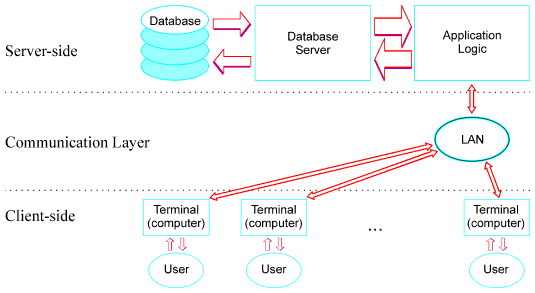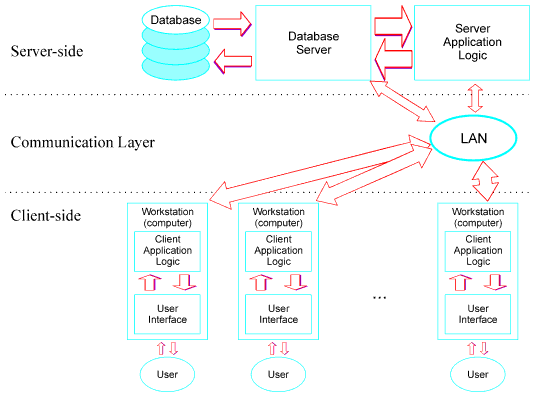DMAL® Technology and its usage in the MRP K/S Accounting System
The time-tested architecture of the client/server-based applications (as shown in fig. 1) evidently dates back to the period when large (especially in size) mainframe computers were in use. At that time, the computing performance of the server-side and of the client-side in the computing networks differed by several ranks. Usual transmission speed of then LAN networks was in the region of thousands bps. In view of the facts it was necessary to modify the software creation to hardware requirements. The whole application logic was concentrated in the server-side, the client-side was represented by a simple terminal. On the one hand, the terminal instructed the application logic to carry out simple operations, on the other hand, it only displayed results of those operations received from the application logic concentrated in the server-side. Using a present-day language we can speak of the super-thin client-side of the software applications. Since then (cca 25 years back), the area of the computing network performance has made many fundamental changes. To mention the most important ones see hereinafter:
- The computing performance of the server/client-sides has increased radically
- The communication networks throughput has increased by several ranks
- The computing performance ratio both of the server and of the client-sides
has reduced essentially (they are comparable in practice)

Fig. 1: Standard Client/Server-based architecture
Before we started the development of the MRP-Client/Server-based accounting application we performed a number of measurements of the present-day LAN networks. Originally we considered to aim our effort towards the development of the thin and super-thin client. In view of the specific problems of the accounting systems used with small and medium-sized firms we came to the conclusion that insisting on the thin client-side would depart us from the objectives set formerly. So as not to abandon the prior objectives we decided, in regard to the present-day PCś computing performance and the data transmission speed in the LAN networks to drop the Client/Server based Applications (see fig. 1).
We came up with a new project (as shown in fig. 2) called Client/Server-based Architecture with the DMAL® Technology (Decentralized Multiplex Application Logic).

Fig.2: Client/Server-based Architecture with the DMAL®
Technology (Decentralized Multiplex Application Logic)
Why Decentralized Multiplex Application Logic?
- In the standard client/server-based application (as shown in fig. 1), practically the whole application logic was centralized in the server-side. We decided to break the deep-rooted standard and decentralized the logic to workstations. As a matter of course, a part of the application logic has been preserved in the server-side (see fig. 2). We have performed the division in the following way:
- The part of application logic requiring large dataflows has been concentrated in the server-side.
- The part of application logic characterized by superior intelligence has been chiefly concentrated in the client-side.
- The user program interface in cooperation with the client application logic is capable to select a task (or its part) that is to be performed by the application logic of the serve-side and which one will be performed by the application logic concentrated in the client-side. Switching over (multiplexing) between the application logic of the server and the application logic of the client-side is a deterministic process from which the concept of multiplex application logic has been derived.
Advantages of the DMAL Technology usage compared to a standard Client/Server-based Application
- Our customers will appreciate the accelerated development of the software products especially in regard of the dynamic changes of the current accounting regulations.
- Balanced computing performance of single computers in the LAN networks.
- Subjective application speed is comparable to the off-line application speed.
- The user interface of the client-side is no less user-friendly than the interface used so far with our accounting applications being not Client/Server-based.
- Last but not least, an essential price reduction for our end-users. As is usual, prices for the classical Client/Server-based applications of other producers are essentially higher than ours.

